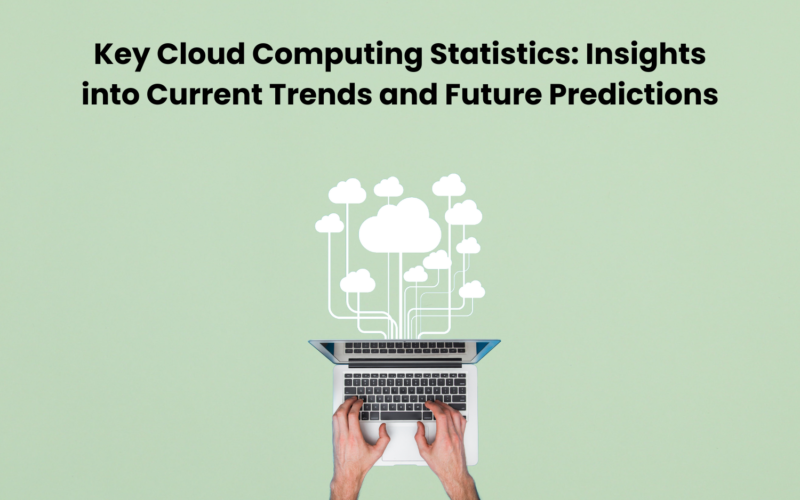In technology, Cloud Computing is a pivotal force reshaping the way businesses operate and individuals interact with digital services. As we navigate this dynamic terrain, understanding the latest Cloud Computing Statistics becomes crucial for staying ahead of the curve. This blog will explore the key cloud computing statistics, offering valuable insights into current trends and predictions for the future.
Table of Contents
- Rapid Adoption of Cloud Computing
- Cloud Spending on the Rise
- The Dominance of Public Cloud Services
- Hybrid Cloud Environments on the Horizon
- Security Concerns in the Cloud
- Cloud-Native Technologies Paving the Way
- Data Explosion and Cloud Storage
- The Role of Cloud Computing in Digital Transformation
- Future Predictions: Edge Computing and AI Integration
- Conclusion
Rapid Adoption of Cloud Computing
The usage of cloud computing has skyrocketed across several sectors. Recent data from RightScale shows that over 94% of enterprises use cloud services. The many advantages of cloud computing, such as scalability, cost-efficiency, and improved collaboration, drive this massive adoption.
Cloud Spending on the Rise
Spending on cloud services has increased significantly, which is one of the most striking facts about cloud computing. Large chunks of companies’ IT spending are going towards cloud-related expenses. Research shows that cloud services will be worth hundreds of billions of dollars worldwide in the next years, proving how important cloud computing is for today’s information technology infrastructure.
The Dominance of Public Cloud Services
Cloud computing is still mostly dominated by public cloud services provided by industry heavyweights such as Microsoft Azure, Amazon Web Services (AWS), and Google Cloud Platform (GCP). RightScale’s 2023 State of the Cloud Report found that 60% of organizations have a hybrid cloud strategy, with some workloads on-premises and some in the cloud. This means that most enterprises are opting for public cloud solutions. This is evident in the reliance on these large providers to offer safe, scalable, and dependable services.
Hybrid Cloud Environments on the Horizon
Hybrid cloud setups are becoming more popular, even as public cloud services continue to do well. More and more organizations are combining public and private cloud solutions to meet performance, security, and compliance standards while keeping costs down. Businesses increasingly turn to hybrid cloud solutions because they provide more leeway to tailor their IT infrastructure to individual requirements.
Security Concerns in the Cloud
People are becoming more aware of the security risks linked to cloud computing as its use becomes more widespread. According to data gathered from the cloud, companies’ primary worry when considering or using cloud services is security. It should be noted that cloud service providers are always working to improve their security measures. It’s more common for successful security breaches to be caused by user misconfigurations than by flaws in the cloud infrastructure itself.
Cloud-Native Technologies Paving the Way
Cloud-native technologies are transforming application development and deployment. Thanks to their exceptional scalability and agility, containerisation, microservices, and serverless computing are quickly becoming popular. Statistics on cloud computing show that these technologies are becoming more popular, with many companies using Kubernetes and other container orchestration tools as part of their cloud strategy.
Data Explosion and Cloud Storage
Cloud storage has emerged as the standard method for handling the unprecedented avalanche of data that the digital age has brought forth. Predictions indicate that the quantity of data handled in the cloud will continue to expand rapidly. In contrast, statistics on cloud computing show the enormous amounts of data kept in the cloud. Strong cloud storage solutions are crucial in light of this data explosion.
The Role of Cloud Computing in Digital Transformation
An integral part of the larger picture of digital transformation is cloud computing. Businesses that use cloud computing are better able to innovate, adjust to changing market conditions, and meet the needs of their customers quickly. Data from cloud computing projects shows that digital transformation efforts benefit greatly from using the cloud.
Future Predictions: Edge Computing and AI Integration
The future of cloud computing may be defined by how edge computing and AI interact. With edge computing, processing power is moved closer to the data source, which improves real-time capabilities and decreases latency. The availability and significance of AI-driven insights are increasing, and cloud computing data show a rising interest in edge solutions.
Conclusion
In conclusion, staying informed about critical cloud computing data is imperative for individuals and enterprises alike. Cloud Computing Courses play a pivotal role in leveraging this technology as a strategic enabler, especially given the growing demand for digital services and the rapid advancement of cloud technology.
These courses shed light on the present and future of cloud computing, making them valuable for both individuals navigating the digital domain and corporate executives developing IT plans. Moving forward, cloud computing courses will be essential in shaping how we interact, collaborate, and innovate in the digital era.










